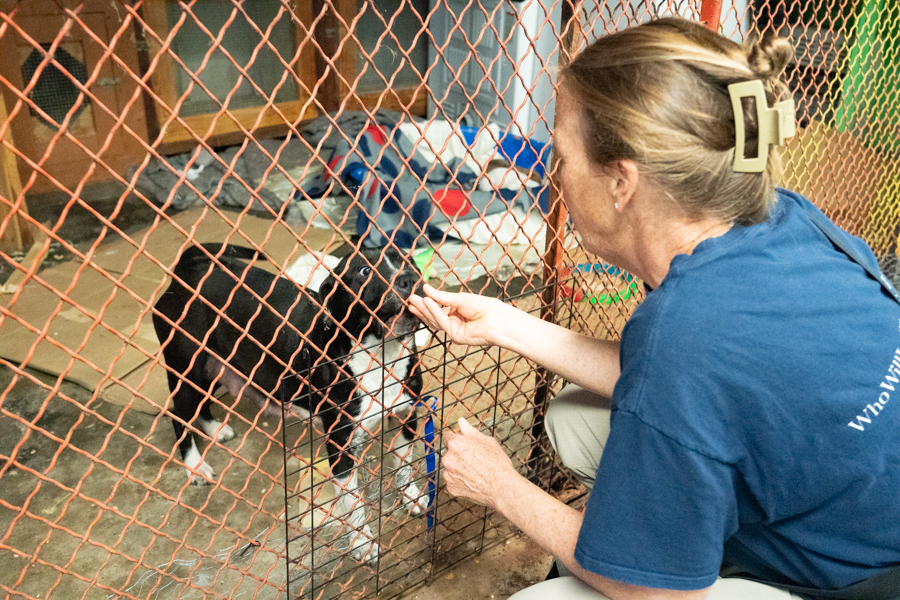It’s been a week since we returned from our latest shelter tour. Once again, it was a learning experience. We visited ten shelters in five states – South Carolina, Alabama, Mississippi, Arkansas, and Kentucky. We spent most of our time in Alabama and Arkansas (with just one stop in the other three states).
I’m not sure I can clearly explain just how desperate the situation has become — in the shelters, and even more so, in the places where there are no municipal shelters. If you work or volunteer in shelters or rescues right now, you probably already know this.
There are dogs crowding the shelters, overwhelming the rescues, forcing directors and ACOs to come up with creative ways to house more dogs or make very difficult decisions.



Fewer dogs are being pulled for transport because so many northern shelters and rescues are moving dogs more slowly and being inundated with local dogs. Nearly every shelter we visited told us they get calls daily with requests for help—mostly to surrender dogs, but sometimes for help with resources like food and veterinary care. They are all doing as much as they can, but they will be the first to tell you it is not enough.
That bleak picture aside, there was also so much hope and so much to celebrate at nearly every stop. First and foremost, the remarkable heroes going so far above and beyond their jobs to save lives.
Daniel, an ACO at Eufaula Animal Control in Eufaula, Alabama pays the vet bills out of his own pocket for his shelter dogs because the county only gives him budget money for staff, building, and food.


Trisha, the director at Monroe County Animal Shelter, the only full time employee (there are also part-timers who put in WAY more than part-time) works inhuman hours caring for the 100 dogs and puppies crowding that shelter. And they all do it for the minimum wage in Alabama ($7.25/hour). They’ve lost rescue partners and in late 2023, with no other choice, they’ve begun having to euthanize about three dogs a week.



In Ashdown, Arkansas, Corinna singlehandedly cares for the 75 dogs in outdoor kennels at A&B Animal Rescue. She works seven days a week, 365 days a year. She does not receive a salary. But with the only other alternative in Ashdown being a dog pound that operates on a 5-day kill ordinance, she struggles to say no.



In Helena-West Helena, Arkansas, Leslie, of Meals on Wheels for Helena-West Helena Dogs, spends hours in her Bronco combing the streets of this city with no animal services, trying to help the strays and the impoverished community. She fosters dogs she can and boards too many puppies to get them off the street.




Arkansas has municipal shelters in most of the cities (mostly dog pounds like the one in Ashdown) and no animal services in the counties. At UCAPS (Union County Animal Protection Society) and CCAPS (Columbia County Animal Protection Society), both nonprofit shelters, leadership has made a commitment not to euthanize for space, but that means dogs can stay with them for years, living in crowded, chaotic conditions with minimal human attention. Both organizations have wonderful volunteers, but simply too many dogs to provide the kind of care and accomodations they’d like to provide.



In Laurens County, South Carolina, a new director is working hard to change the story of the Animal Control Shelter that until she took over was euthanizing dogs regularly because of strained relationships with rescues and locals alike. They are about to move into newly refurbished kennel space with HVAC, better air circulation, spacious kennels, and new Kuranda beds for many of the dogs (thanks to an Instagrant we just awarded them). Melony is excited about the future of the shelter and hoping volunteers will discover that things are different now and want to get involved.



At Montgomery Humane, a hybrid municipal/nonprofit shelter, they have seen their numbers come down some thanks to community assistance programs and their commitment to spay/neuter, but they are still euthanizing about 50% of dogs over twenty-five pounds. They are a large shelter with a dedicated and high-performing staff (and ACOs) who engage their community on many levels and have strong volunteer and foster programs. They’ve chosen to focus on fixing the problem and not simply exporting the majority of their dogs north (although they do work with foster-based rescues and breed-specific rescues).



And at Meade County Animal Control in Brandenburg, Kentucky, thanks to Troy Kok, the new Judge Executive (animal services in that state fall to the JE), they have finally ceased operating as a dog pound and in less than a year have become a real shelter saving all the adoptable animals instead of killing them at the end of their stray hold. There’s an exciting energy at Meade County, as they work on plans for a new shelter they believe will be the best shelter in Kentucky.



I will share the stories of each of these visits in coming blog posts, examining the issues that arise from each. It is unfair to leave these challenges on the hearts and in the hands of these heroic people who are facing what feels like an endless stream of need. We can save these dogs and we should, but we won’t be able to until we find new solutions. The programs and policies that have brought us so far cannot fix this.
Driving three thousand miles on this tour, I’ve held fast to the mantra, “Nothing changes if nothing changes.”
It’s time for real change. It’s time to have real conversations about the issues in our communities and engage them in being part of the solution and not the source of the problem.

Until each one has a home,
Cara
If you want to learn more, be sure to subscribe to this blog. And help us spread the word by sharing this post with others. Visit our website to learn more.
You can also help raise awareness by following/commenting/sharing us on Facebook, Instagram, YouTube, and Tik Tok.
To see our Emmy-nominated, award-winning short documentary, Amber’s Halfway Home, click here. If you’d like to see it on the big screen (along with other short dog films), check out the tour schedule of The Dog Film Festival, currently in art movie houses all over the country.

Learn more about what is happening in our southern shelters and rescues in the book, One Hundred Dogs & Counting: One Woman, Ten Thousand Miles, and a Journey Into the Heart of Shelters and Rescues (Pegasus Books, 2020). It’s the story of a challenging foster dog who inspired me to travel south to find out where all the dogs were coming from. It tells the story of how Who Will Let the Dogs Out began. Find it anywhere books are sold. A portion of the proceeds of every book sold go to help unwanted animals in the south.
For more information on any of our projects, to talk about rescue in your neck of the woods, or become a WWLDO volunteer, please email whowillletthedogsout@gmail.com or carasueachterberg@gmail.com.
And for links to everything WWLDO check out our Linktree.



Terrie
Thank you for what you are doing!!! It is about time people are educated before getting a dog and not dumping them on people who care. I have worked in a shelter
In Nashville TN. So I know what you are up against.